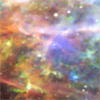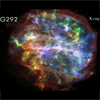CXC Home | Search | Help | Image Use Policy | Latest Images | Privacy | Accessibility | Glossary | Q&A
Tour of G292.01+8
Quicktime MPEG
This image shows how complex a star's afterlife can be. At a distance of about 20,000 light years, G292 is one of only three supernova remnants in the Milky Way galaxy known to contain large amounts of oxygen. This image from Chandra shows us that G292 is now a rapidly-expanding debris field that contains, along with oxygen, other elements such as neon and silicon that were forged in the star before it exploded.
By mapping the distribution of X-rays in different energy bands, astronomers can trace the distribution of chemical elements ejected in the supernova. The results imply that the explosion was not symmetrical. For example, silicon and sulfur, which are colored blue in this image, and magnesium, which is green, are seen strongly in the upper right. On the other hand, oxygen, which appears as yellow and orange, dominates the lower left. Studying the details of this X-ray image allows astronomers to better understand how some stars die and disperse important elements like oxygen into the next generation of stars and planets.
[Runtime: 01:11]
Quicktime MPEG
This image shows how complex a star's afterlife can be. At a distance of about 20,000 light years, G292 is one of only three supernova remnants in the Milky Way galaxy known to contain large amounts of oxygen. This image from Chandra shows us that G292 is now a rapidly-expanding debris field that contains, along with oxygen, other elements such as neon and silicon that were forged in the star before it exploded.
By mapping the distribution of X-rays in different energy bands, astronomers can trace the distribution of chemical elements ejected in the supernova. The results imply that the explosion was not symmetrical. For example, silicon and sulfur, which are colored blue in this image, and magnesium, which is green, are seen strongly in the upper right. On the other hand, oxygen, which appears as yellow and orange, dominates the lower left. Studying the details of this X-ray image allows astronomers to better understand how some stars die and disperse important elements like oxygen into the next generation of stars and planets.
[Runtime: 01:11]
(Credit: X-ray: NASA/CXC/Penn State/S.Park et al.; Optical: Pal.Obs. DSS)
X-ray Images of G292.0+1.8
Quicktime MPEG
Chandra's image of G292.0+1.8 shows remarkable complexity and structure in the debris field of this exploded star. Each color represents different elements such as oxygen, neon, magnesium, and silicon. The distribution of these elements gives astronomers clues about how the star exploded. The view then zooms into the region around the dense core that remains of the star, seen in the highest-energy X-rays detected by Chandra.
[Runtime: 0:12]
(Credit: X-ray: NASA/CXC/Penn State/S.Park et al.; Optical: Pal.Obs. DSS )
Quicktime MPEG
Chandra's image of G292.0+1.8 shows remarkable complexity and structure in the debris field of this exploded star. Each color represents different elements such as oxygen, neon, magnesium, and silicon. The distribution of these elements gives astronomers clues about how the star exploded. The view then zooms into the region around the dense core that remains of the star, seen in the highest-energy X-rays detected by Chandra.
[Runtime: 0:12]
(Credit: X-ray: NASA/CXC/Penn State/S.Park et al.; Optical: Pal.Obs. DSS )
Animation of a Supernova Explosion
Quicktime MPEG
When a massive star explodes like the one that produced G292.0+1.8, it creates a shell of hot gas that glows brightly in X-rays. This animation shows this process and depicts the stellar debris that Chandra is able to observe, revealing the dynamics of the explosion. With nearly six days of Chandra observing time devoted to studying G292.0+1.8, astronomers hope they can use this particular remnant to better understand the complicated details of such an explosion.
[Runtime: 0:12]
(Credit: NASA/CXC/A.Hobart)
Quicktime MPEG
When a massive star explodes like the one that produced G292.0+1.8, it creates a shell of hot gas that glows brightly in X-rays. This animation shows this process and depicts the stellar debris that Chandra is able to observe, revealing the dynamics of the explosion. With nearly six days of Chandra observing time devoted to studying G292.0+1.8, astronomers hope they can use this particular remnant to better understand the complicated details of such an explosion.
[Runtime: 0:12]
(Credit: NASA/CXC/A.Hobart)
Return to G292.0+1.8 (October 23, 2007)





